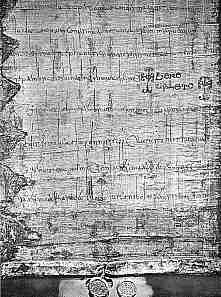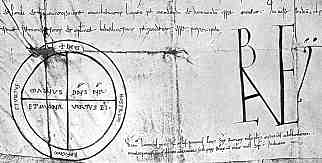




If you are looking at this page without frames, there is more information about medieval writing to be found by going to the home page (framed) or the site map (no frames).
| Papal Bulls | ||||
| A papal bull is a form of charter or diploma issued under the authority of the pope. The name refers to the unique lead bulla or seal which was used to authenticate the document. Papal bulls have many features in common with Germanic diplomas, both having originated from forms of Roman Imperial documents, and both having developed in parallel. The competing authority of church and state over the centuries seems to be mirrored in competing styles of their most significant documents. | ||||
 |
The papal bull was a formal letter, delivered open, with its seals attached to the bottom of the single sheet which was written only on one side. They recorded the granting of privilege or issued instructions. Until the 11th century they were written on papyrus, continuing a tradition from the Roman Empire. They were documents of great formality, and over the centuries the most solemn grade developed a range of elaborate symbolic features. | |||
| This damaged fragment of a bull of Pope Leo IV, from AD 850, shows some of the features of the early form. (Rome, Biblioteca Vaticana, Sala dei papiri, I) (From Steffens 1929) | ||||
 |
The early script is known as curialis, a narrow, compressed script with exaggerated ascenders and descenders and some unusual letter forms. It was unique, although similar in general appearance to other early European chancery hands. | |||
 |
The use of formal graphic symbols and the formula Bene Valete was something that would become further elaborated over the centuries. The characteristic texture of papyrus can be seen in this detail. | |||
 |
The lead seals have only a written inscription; on one side LEONIS and on the other PAPA. Pictorial seals did not appear until the mid 11th century. | |||
| By the 11th century papal bulls were being written on parchment. The curialis script was being modified, taking some letter forms from Caroline minuscule while still retaining some forms from the old curialis. The form of words was very elaborate and included, after the body of the grant or instruction, some seriously ferocious curses upon the head of anyone who did not obey the instructions contained therein. It included the sign manual of the pope, which was a circular diagram containing various inscriptions. The Bene Valete formula was turned into a monogram. The date was entered in an elaborate format, or multiple formats which could include ancient Roman forms of dating as well as the year of the reign of the pope and perhaps the German emperor as well. The seal depicted the heads of Saints Peter and Paul, with an inscription on the reverse side. | ||||
 |
Detail of a bull of Alexander II from 1071 (Milan, Archivio di Stato), showing the circular sign manual of the pope and the Bene Valete monogram, followed by a curly punctuation mark. The date is entered below it. (From Steffens 1929) | |||
| In the 12th century a range of grades of papal documents became stereotyped with special identifying features. Certain features of script were adopted from the German Imperial chancery, simplified somewhat and then elaborated again. This papal form of diplomatic minuscule was based on Caroline minuscule with various elaborations. The documents were highly recognisable and for any monastic or other religious institution, signified the highest authority for any privileges contained therein. | ||||
|
|
||||
|
If you are looking at this page without frames, there is more information about medieval writing to be found by going to the home page (framed) or the site map (no frames). |
||||